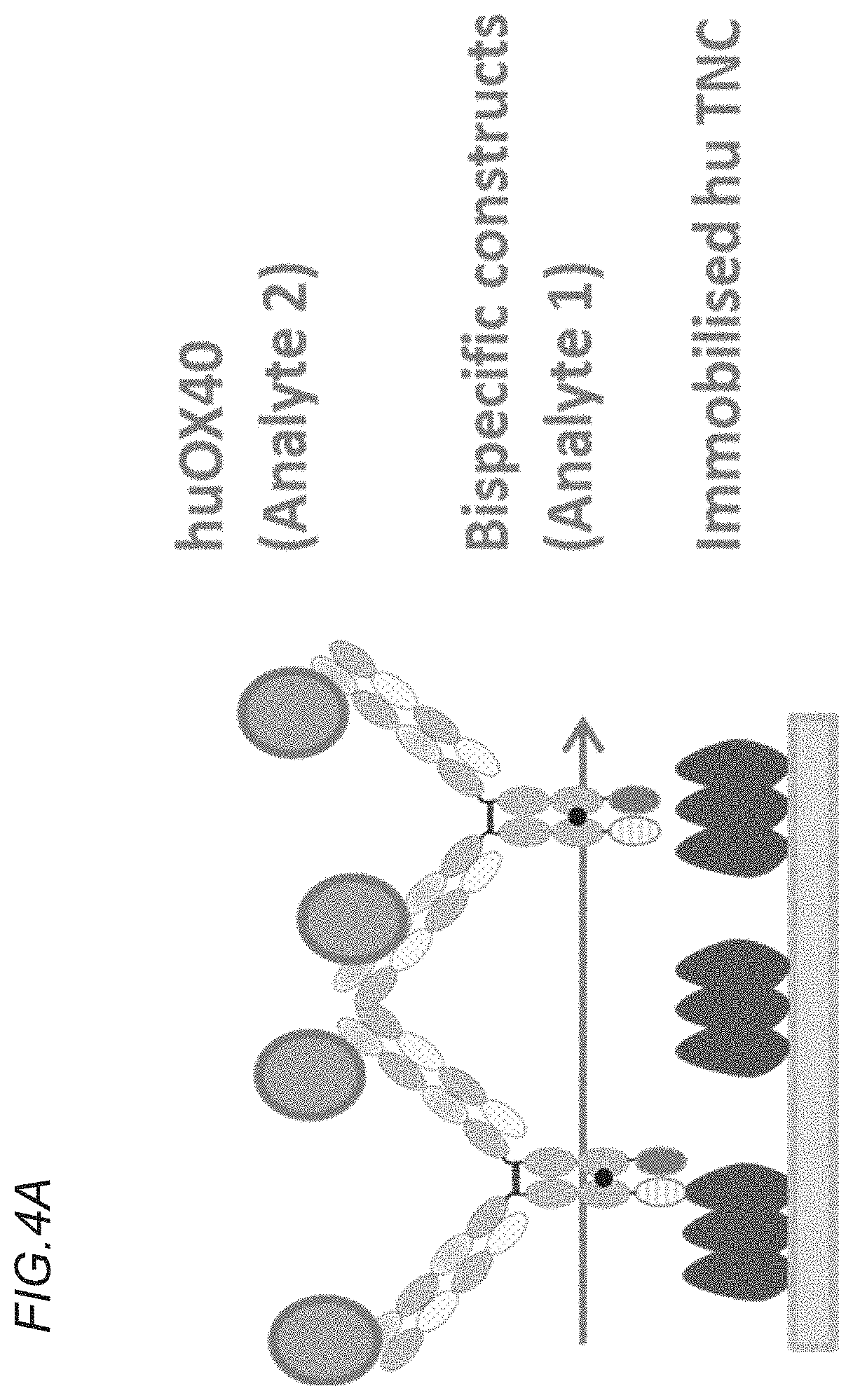Bispecific antigen binding molecule for a costimulatory TNF receptor
a tnf receptor and bispecific technology, applied in the field of bispecific antigen binding molecules, can solve the problems of increasing complexity of inter- and intracellular signaling mechanisms, and achieve the effect of prolonging cytotoxic t cell activity
- Summary
- Abstract
- Description
- Claims
- Application Information
AI Technical Summary
Benefits of technology
Problems solved by technology
Method used
Image
Examples
example 1
Generation of OX40 Antibodies
1.1 Preparation, Purification and Characterization of Antigens and Screening Tools for the Generation of Novel OX40 Binders by Phage Display
[0473]DNA sequences encoding the ectodomains of human, mouse or cynomolgus OX40 (Table 1) were subcloned in frame with the human IgG1 heavy chain CH2 and CH3 domains on the knob (Merchant et al., Nat Biotechnol (1998) 16, 677-681). An AcTEV protease cleavage site was introduced between an antigen ectodomain and the Fc of human IgG1. An Avi tag for directed biotinylation was introduced at the C-terminus of the antigen-Fc knob. Combination of the antigen-Fc knob chain containing the S354C / T366W mutations, with a Fc hole chain containing the Y349C / T366S / L368A / Y407V mutations allows generation of a heterodimer which includes a single copy of the OX40 ectodomain containing chain, thus creating a monomeric form of Fc-linked antigen (FIG. 1). Table 1 shows the amino acid sequences of the various OX40 ectodomains. Table 2 th...
example 2
Generation of Tenascin C (TnC) Antibodies
2.1 Preparation, Purification and Characterization of Antigens and Screening Tools for the Generation of Novel TnC Binders by Phage Display
[0499]The constructs of Table 15 and Table 16 were fused to the C-term of GST, and expressed in E. coli BL21(DE3). For site-specific biotinylation, the Avi-tag was added to the C-term of the tenascin sequence, and the BirA biotin ligase was coexpressed on a separate plasmid (Avidity, Colo., USA). Growth medium was 2YT with 100 μg / ml ampicillin and 20 μg / ml chloramphenicol. Biotin was added to a final concentration of 50 μM. Protein Expression was induced with 1 mM IPTG at 22° C. overnight. Cells were harvested by centrifugation, and cell-lysis was performed by sonication in the presence of B-PER reagent (pierce 78260), and 1 mg / ml lysozyme (Sigma L6876). Lysate was centrifuged and cleared lysate was loaded on Glutathione Sepharose columns (GE Healthcare; Product No 17-0756-01). After washing, the TnC molec...
example 3
Generation of Bispecific Antibodies Targeting OX40 and Tenascin C (TnC)
3.1 Generation of Bispecific Antibodies Targeting OX40 and Tenascin C (TnC)
[0514]Bispecific agonistic OX40 constructs with bivalent binding for OX40, and bivalent binding for TnC (i.e. ‘2+2’ constructs) were prepared.
[0515]In this example, the heavy chain (HC) of the construct was comprised of the following components: VHCH1 of anti-OX40 49B4 Fc (P329G / LALA), followed by a (G4S)4 linker and VHCH1 of anti-TnC clone 18D4 or 11C7. The Pro329Gly, Leu234Ala and Leu235Ala mutations have been introduced in the constant region of the heavy chains to abrogate binding to Fc gamma receptors according to the method described in International Patent Appl. Publ. No. WO 2012 / 130831 A1. This heavy chain fusion was co-expressed with the light chain of the anti-Ox40 49B4 (VLCL) as well as the cross-Fab LC of 18D4 or 11C7 (VLCH1). Crossmab technology was employed for the TnC binding moiety to reduce the formation of wrongly paired ...
PUM
| Property | Measurement | Unit |
|---|---|---|
| binding affinity | aaaaa | aaaaa |
Abstract
Description
Claims
Application Information
 Login to View More
Login to View More - R&D
- Intellectual Property
- Life Sciences
- Materials
- Tech Scout
- Unparalleled Data Quality
- Higher Quality Content
- 60% Fewer Hallucinations
Browse by: Latest US Patents, China's latest patents, Technical Efficacy Thesaurus, Application Domain, Technology Topic, Popular Technical Reports.
© 2025 PatSnap. All rights reserved.Legal|Privacy policy|Modern Slavery Act Transparency Statement|Sitemap|About US| Contact US: help@patsnap.com



